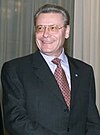Moldavian Supreme Soviet election, 1990
|
|
||||||||||||||||
|---|---|---|---|---|---|---|---|---|---|---|---|---|---|---|---|---|
|
||||||||||||||||
|
All the 380 seats to the Parliament of Moldova |
||||||||||||||||
|
||||||||||||||||
Parliamentary elections were held in the Moldavian SSR in February and March 1990 to elect the 380 members of the Supreme Soviet. They were the first and only free elections to the Supreme Soviet of the MSSR, and although the Communist Party of Moldova was the only registered party allowed to contest the election, opposition candidates were allowed to run as independents. Together with affiliated groups, the Popular Front of Moldova won a landslide victory. Candidates who were openly supporters of the Popular Front won about 27% of seats; together with moderate Communists, mainly from rural districts, they commanded a majority.
On 5 June the Supreme Soviet renamed the Moldavian SSR the "Soviet Socialist Republic of Moldova" and issued a Declaration of Sovereignty on 23 June. It subsequently removed references to socialism and soviets on 23 May 1991 by adopting the name "Republic of Moldova". It subsequently declared full independence from the Soviet Union on 27 August 1991. The next legislature was elected as the Parliament of Moldova in 1994.
All 380 deputies were elected in uninominal constituencies. The first sitting of the parliament was held on April 17, 1990.
The Popular Front of Moldova gained complete control once Gagauz and Transnistrian deputies walked out in protest over Romanian-oriented cultural reforms. One leader of the Popular Front of Moldova, Mircea Druc, formed the new government. The Popular Front saw its government as a purely transitional ministry; its role was to dissolve the Moldavian SSR and join Romania.
...
Wikipedia

